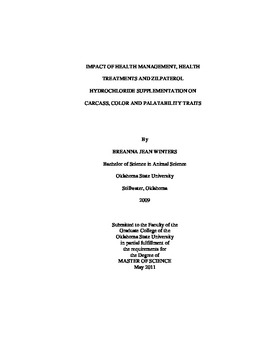| dc.contributor.author | Winters, Breanna Jean | |
| dc.date.accessioned | 2014-04-15T20:13:19Z | |
| dc.date.available | 2014-04-15T20:13:19Z | |
| dc.date.issued | 2011-05-01 | |
| dc.identifier.uri | https://hdl.handle.net/11244/8894 | |
| dc.description.abstract | Two hundred sixty eight strip loins were collected from heifers fed at Oklahoma State Univesity in Stillwater, OK. In phase I, 127 heifers were assigned to one of three treatment groups. Antimicrobial administrations (AA) were given based on visual assessment (VA), rumen temperature (RT) or given a metaphylactic treatment of Draxxin (MT) followed by visual assessment. In phase II, 155 heifers were assigned to two treatment groups, control (CON) and zilpaterol hydrochloride (ZH). Three steaks were collected from each strip loin, one each for retail display, sensory evaluation and Warner-Bratzler shear force (WBSF). Color was evaluated from the retail display steak using a trained color panel and objectively using a HunterLab Miniscan XE. An Instron Universal Testing Machine with a Warner-Bratzler head was used for evaluation of instrumental tenderness, and a trained sensory panel was used to assess palatability traits. Heifers treated by VA had the least number of AA, lowest yield grade and also had the lightest hot carcass weights compared to the heifers treated by the other health management protocols. There were no subjective color attribute differences or sensory panel differences across all health management systems or AA. There were no differences in carcass and performance traits for any AA treatment groups. Heifers who had 0 or 1 AA had lower a* and b* values compared to those who had 2 AA. In phase II, heifers treated by VA had the least number of AA when compared with MT and RT. Health management group did not have any other effects in carcass, sensory or color attributes. Across all AA, fat thickness, internal fat and marbling all decreased as AA increased. Zilpaterol hydrochloride supplementation caused a decrease in internal fat and yield grade, but no interactions between the number of AA and ZH supplementation. As AA increased, tenderness increased and amount of detectable connective tissue decreased. With the supplementation of ZH, there was a negative effect on tenderness, which caused a significant increase in WBSF. At the end of the retail display, the control group had a greater amount of surface discoloration when compared to the ZH group. | |
| dc.format | application/pdf | |
| dc.language | en_US | |
| dc.publisher | Oklahoma State University | |
| dc.rights | Copyright is held by the author who has granted the Oklahoma State University Library the non-exclusive right to share this material in its institutional repository. Contact Digital Library Services at lib-dls@okstate.edu or 405-744-9161 for the permission policy on the use, reproduction or distribution of this material. | |
| dc.title | Impact of Health Management, Health Treatments and Zilpaterol Hydrochloride Supplementation on Carcass, Color and Palatability Traits | |
| dc.type | text | |
| osu.filename | Winters_okstate_0664M_11320.pdf | |
| osu.college | Agricultural Sciences and Natural Resources | |
| osu.accesstype | Open Access | |
| dc.description.department | Department of Animal Science | |
| dc.type.genre | Thesis | |
| dc.subject.keywords | beta agonist | |
| dc.subject.keywords | brd | |
| dc.subject.keywords | health | |
